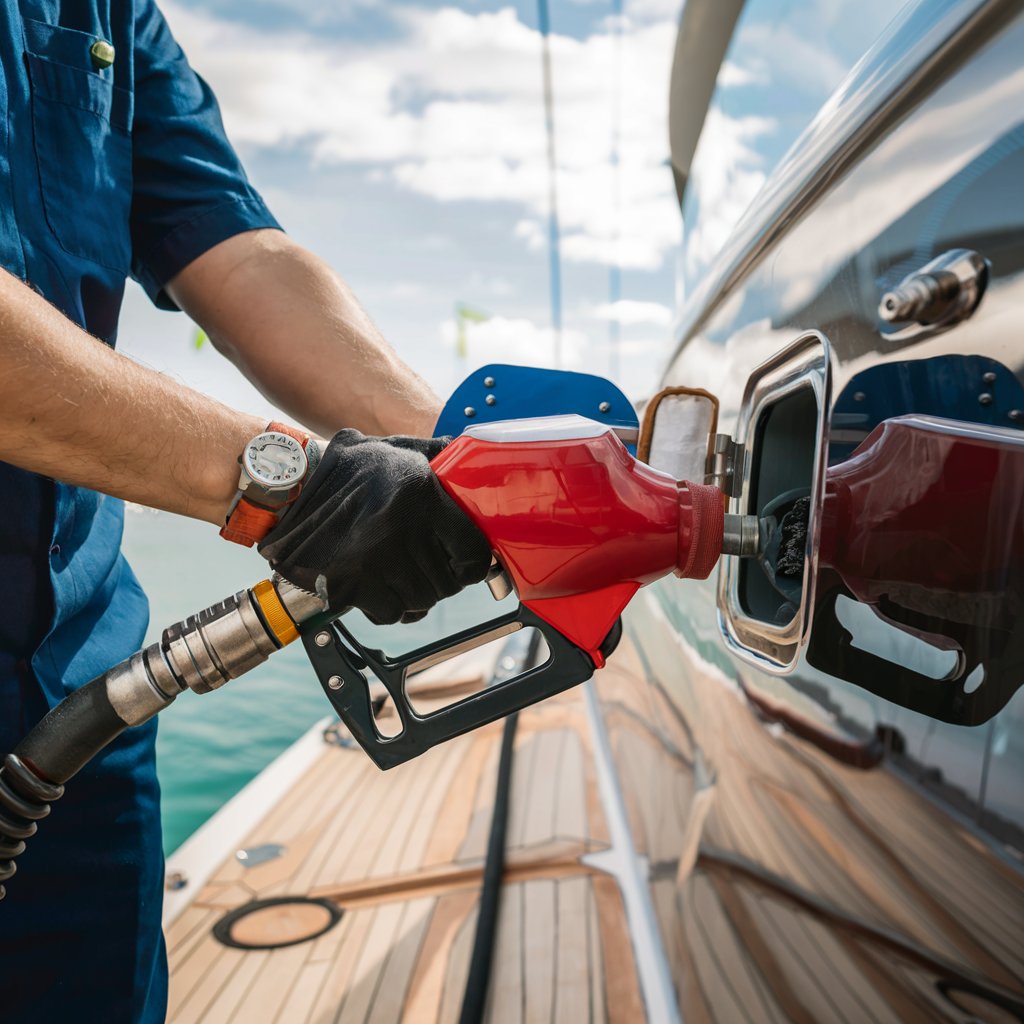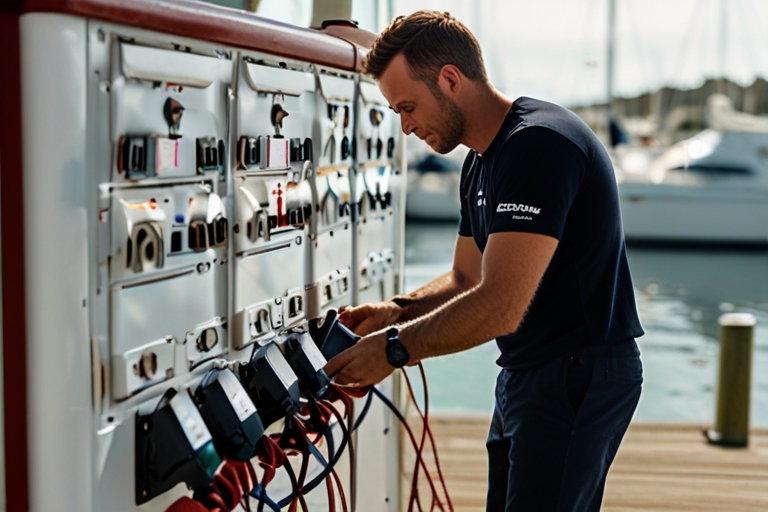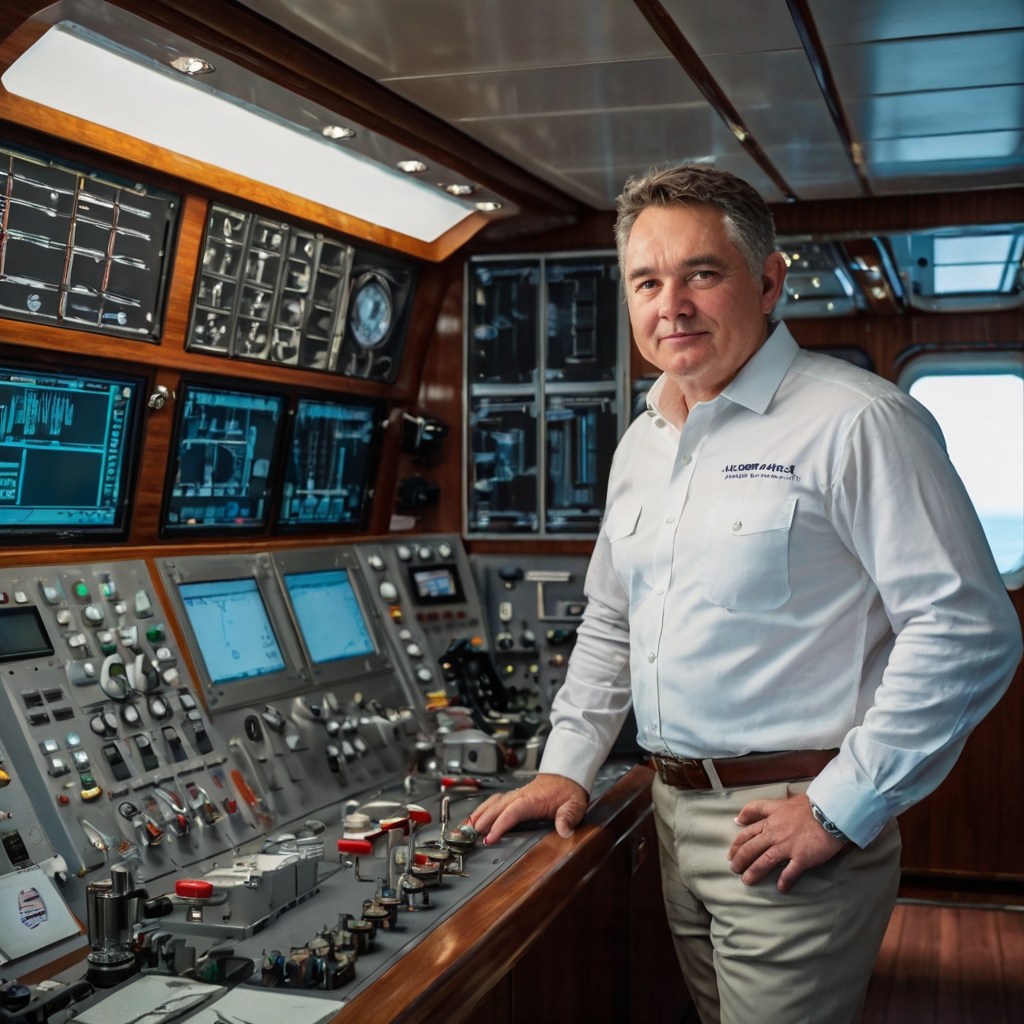Series: ”Behind the Scenes”
Introduction
Life on a Yacht is often perceived as Glamorous and Luxurious, but behind the scenes, a dedicated team works tirelessly to ensure everything runs smoothly. Among them, the Chief Engineer plays a pivotal role. He and his team of fellow engineers are the heartbeat of a yacht’s technical operations. Their oversight ensures the smooth functioning of systems, guaranteeing the comfort and safety of all guests and crew.
This article delves into the fascinating and demanding life of a yacht’s Chief Engineer, highlighting their responsibilities, challenges, and the skills required to excel in this critical position.
What Are the Duties of a Yacht’s Chief Engineer?
The chief engineer on a yacht holds a critical role, tasked with the comprehensive management and maintenance of all mechanical and electrical systems aboard. One of their primary duties is to oversee the operation of the yacht’s engines, ensuring they run smoothly and efficiently. This includes performing regular inspections, routine maintenance, and necessary repairs to avoid any technical failures. The Chief Engineer also manages the yacht’s power generation and distribution systems, which are vital for the operation of all onboard equipment and amenities. In addition, they are responsible for the HVAC systems, ensuring that the living and working conditions on the yacht are comfortable for both guests and crew.
The Chief Engineer is also responsible for overseeing the yacht’s fueling process, meticulously planning and overseeing fuel management to ensure optimal performance and efficiency. They are responsible for coordinating with fuel suppliers, monitoring fuel levels, and ensuring that this process is completed safely and effectively.
Image showing engineering team member about to initiate the fueling process for the yacht.

Beyond technical maintenance, the Chief Engineer plays a crucial role in safety and compliance. They are responsible for ensuring that all safety equipment, such as fire suppression systems and emergency power supplies, are in proper working order. He or she must also ensure that the yacht complies with all relevant Maritime Regulations and Standards, including pollution prevention and Waste Management Protocols.

Discover the ultimate yacht rental experience with Searadar! Whether you’re a seasoned sailor or a first-time adventurer, Searadar simplifies yacht chartering with an extensive selection of vessels across the world’s most stunning destinations. Enjoy personalized service, easy booking, and expert support every step of the way. Set sail with confidence and let Searadar make your dream voyage a reality today! Visit Searadar to explore your next adventure.
The Chief Engineer works closely with the Captain and other senior crew members to coordinate maintenance schedules and address any technical issues that may arise during a Voyage. Their role requires not only technical expertise but also strong organizational and problem-solving skills to keep the yacht running efficiently and safely at all times.
Sometimes the Chief Engineer may be called upon by the Owner of the Yacht, who can sometimes be difficult to deal with, to communicate complex technical information, addressing concerns about the yacht’s performance or safety, and managing the owner’s expectations regarding maintenance schedules and costs.
For a Chief Engineer, the day starts much before the sunrise gleams off the water, ensuring that this Floating Palace remains precisely that—a flawless escape on the seas.
Ever wondered what the typical schedule of the Chief Engineer is? lets dive in and take a look!
Early Morning: Prepping for the Day
- 5:30 AM – Rise and Shine: The day begins early for the chief engineer. They start with a quick breakfast and a strong coffee, essential for the long hours ahead.
- 6:00 AM – Engine Room Inspection: The first task is a thorough inspection of the engine room. This includes checking the oil levels, coolant, and fuel, as well as ensuring all systems are operational. Any signs of potential issues are noted and addressed immediately.
- 6:45 AM – Power Systems Check: Next, they check the yacht’s power systems. This includes generators, inverters, and batteries. Ensuring a steady and reliable power supply is crucial for the yacht’s operations and guest comfort.
Mid-Morning: Maintenance and Repairs
- 8:00 AM – Meeting with the Captain: The chief engineer meets with the captain to discuss the day’s itinerary and any potential technical challenges. Communication between the captain and the engineering team is key to smooth sailing.
- 9:00 AM – Routine Maintenance: Routine maintenance is carried out on various systems, including HVAC, water desalination, and Sewage Treatment. This ensures all amenities function perfectly.
- 10:30 AM – Troubleshooting: Any issues identified during the morning inspections are addressed. This could involve anything from fixing a minor leak to recalibrating Navigation Equipment.
Afternoon: Monitoring and Planning
- 12:00 PM – Lunch Break: Even a Chief Engineer needs a break. A Quick, Nutritious Lunch helps recharge for the busy afternoon ahead.
- 1:00 PM – System Monitoring: Continuous monitoring of all systems is essential. The Chief Engineer checks the engine performance, fuel consumption, and power usage, ensuring everything is within optimal parameters.
- 3:00 PM – Inventory Check: They conduct an inventory check of Spare Parts and Essential Supplies. Keeping a well-stocked inventory is critical for immediate repairs and maintenance.
Evening: Wrapping Up
- 5:00 PM – Daily Report: The Chief Engineer prepares a daily report summarizing the day’s activities, any issues encountered, and maintenance performed. This report is shared with the Captain and other Senior Crew Members.
- 6:00 PM – Final Inspections: Before the day ends, they conduct one last round of inspections, ensuring everything is in order for the night and the following day.
- 7:00 PM – Dinner and Rest: After a long day, the Chief Engineer joins the crew for dinner, followed by some well-deserved rest.
Key Responsibilities of a Yacht’s Chief Engineer
- Preventative Maintenance: Regularly servicing and maintaining all mechanical and electrical systems to prevent breakdowns.
- Emergency Repairs: Quickly diagnosing and fixing issues that arise, minimizing downtime and ensuring safety.
- System Monitoring: Continuously monitoring engine performance, fuel levels, and other critical systems.
- Inventory Management: Keeping track of Spare Parts, Tools, and Supplies to ensure readiness for any situation.
- Team Coordination: Working closely with the captain and other Crew Members to ensure smooth operations.
Each day, the Chief Engineer treads the fine line between routine checks to determine any potential curveball like a sudden system hiccup that needs immediate attention. Imagine an uncommon rattle or a sudden drop in pressure—issues that would go unnoticed by most are caught by the well-tuned senses of an effective Chief Engineer. This means that troubleshooting skills are crucial. They need to diagnose problems swiftly and implement solutions even faster, often improvising with the tools and materials at hand.
They call the Chief Engineer the heartbeat of the Yacht, and with good reason. Taking care of the mechanical and electrical systems isn’t just about following a checklist—it’s about understanding the intricacies of every humming, whirring part and ensuring they all sing in harmony.
Image Showing Engineering Team Member Plugging the Yacht into Shore Power.


Challenges are common onboard a yacht. Whether it’s diagnosing an obscure sound that doesn’t quite fit or bracing against the raw forces of nature that test the integrity of the vessel, it’s the Chief Engineer’s task to solve these puzzles efficiently and swiftly.
At the end of the day, the leadership prowess of the Chief Engineer is more than just a part of the job—it’s essential. He and his team of engineers must all pull together, aligning their efforts with the Rest of the Crew to create a seamless experience for those they carry across the waves.
Becoming the Chief Engineer on a Yacht
Becoming the chief engineer on a luxury yacht is a career that demands extensive Training, experience, and dedication. Typically, an aspiring yacht engineer starts with a formal education in marine engineering or a related field, often obtaining a degree or certification from a maritime academy. This educational foundation is crucial, as it provides the technical knowledge required to understand the complex systems aboard a yacht. After formal education, practical experience is essential.
Most chief engineers begin their careers in junior positions, such as an assistant engineer or third engineer, where they gain hands-on experience in maintaining and repairing yacht systems. This period of apprenticeship is vital for developing the skills and confidence needed to handle the responsibilities of a chief engineer.

Discover top-quality pet essentials at Pet Care Supplies! Whether you’re looking for flea and tick treatments, dewormers, or health supplements, we’ve got everything to keep your furry friends happy and healthy. Enjoy unbeatable prices on trusted brands and free shipping on all orders. Take the stress out of pet care—shop with us today and give your pets the care they deserve! Visit Pet Care Supplies by clicking Ad below!
In addition to technical training and experience, becoming a chief engineer on a luxury yacht requires a strong understanding of Maritime Regulations and safety standards. Aspiring engineers must obtain various certifications, such as the STCW (Standards of Training, Certification, and Watchkeeping for Seafarers) and other specialized qualifications related to marine safety and engineering.
Furthermore, the role demands excellent problem-solving abilities, leadership skills, and the capacity to work under pressure, as they must manage a team of engineers and coordinate closely with the captain and other senior crew members. Networking within the yachting industry and building a reputation for reliability and expertise can also significantly enhance career prospects. For those with the passion and perseverance to pursue this challenging path, the role of a Chief Engineer on a Luxury Yacht offers a rewarding and lucrative career.
How Much Does the Chief Engineer Make on a Yacht?
The compensation for a Chief Engineer on a yacht varies widely based on several factors, including the yacht’s size, the owner’s preferences, and the engineer’s experience and qualifications. On average, a Chief Engineer on a smaller yacht (up to 40 meters) can expect to earn between $60,000 and $90,000 per year. For those working on mid-sized yachts (40 to 60 meters), salaries typically range from $90,000 to $130,000 annually. Engineers on superyachts (over 60 meters) can command salaries exceeding $150,000, with some highly experienced professionals earning more than $200,000 per year.
In addition to their base salary, Chief Engineers often receive comprehensive benefits packages, including health insurance, accommodation, meals, and sometimes performance bonuses, all of which enhance the overall compensation. These attractive salaries reflect the high level of expertise, responsibility, and dedication required to maintain and operate the complex systems of a luxury yacht.
Mastering the Elements: Skills and Resilience of a Chief Engineer
So, there we have it. Being a yacht’s Chief Engineer isn’t just about keeping a keen eye on propellers and pistons. It’s a multifaceted role that extends far beyond the engine room. This position demands a profound understanding of the yacht’s heart and soul: its technical systems. It’s not enough to be familiar with how things work; Chief Engineers must have an intimate knowledge of each component, from the largest engine to the smallest sensor.

Above all, resilience is the Chief Engineer’s silent anthem. The Seas can be Unforgiving, the hours long, and the conditions taxing. Despite this, these professionals maintain their composure, using their technical prowess to turn challenges into non-issues. And in doing this, they preserve the serenity of the sea-faring experience for everyone aboard.
So, if you are one of the privileged few who can afford to enjoy yachting, the next time you step aboard, remember the integral role of the Chief Engineer. They’re the masterminds who harmonize the ship’s rhythm, ensuring that the only thing passengers need to worry about is enjoying the journey.
This wraps up our exploration of a Yacht’s Chief Engineer. Now, we encourage you to dive into the next article in our “Behind the Scenes” series, where we spotlight the vital role of a Yacht’s Chef. Discover the exceptional culinary talents that make them the heart of the crew, ensuring smooth operations and unparalleled dining experiences on board. Don’t miss out on learning what it takes to manage the galley, support the team, and create the luxurious meals that define yachting excellence!
**Our Website contains affiliate links. This means if you click and make a purchase, we may receive a small commission. Don’t worry, there is no extra cost to you. It’s a simple way you can support our mission to bring you quality content**.

Stay connected no matter where your travels take you with Airalo, the world’s first eSIM store offering affordable data plans in over 200 countries. Say goodbye to expensive roaming fees and the hassle of switching SIM cards. With Airalo, you can easily download a digital eSIM and get instant access to local and international data plans right from your phone. Whether you’re exploring a new city or managing business on the go, Airalo ensures you’re always online, so you can focus on what really matters. Ready to simplify your connectivity? Visit Airalo now by Clicking the Ad Below!


Really cool article and a great insight into what it’s like being a Chief Engineer of a yacht, it’s clearly not all plain sailing (punt totally intended!!!).
Can I ask though how do Engineer’s stay updated with all the advancements in technology, do you have to take/re-take courses to retain certifications to make sure you can continue your role?
Thanks again.
Hi James
Thank you for your feedback! We’re glad you enjoyed the article and appreciated the pun.
To answer your question, yacht engineers stay updated with advancements in technology through a combination of continuous education and hands-on experience.
They often take regular courses and attend training sessions to retain and renew their certifications, ensuring they are well-versed in the latest developments and safety protocols.
This ongoing professional development is crucial for maintaining their role and effectively managing the sophisticated systems onboard modern yachts.
As someone not very familiar with yachts, I am truly fascinated by the insights you shared about the challenging duties of a yacht’s chief engineer. The level of expertise and dedication required to ensure its smooth and safe operation is quite admirable. The meticulous maintenance, problem-solving skills, and commitment to safety that the chief engineer brings to the role makes the job cool in my opinion. Their pivotal role in maintaining the integrity and functionality of the vessel showcases a blend of technical mastery and leadership that is truly impressive.
Hi Elias
Many thanks for your feedback. I am delighted that you enjoyed the article.
This is fascinating because I am an obsessive sailor myself and often see large sleek crafts such as you describe in this article a I sail my dinghy around. I would love to become an engineer on such a vehicle but am still too young. Please could you tell me how best to apply to study the necessary qualifications? Are there any opportunities for internship as I feel I need practical experience as well as qualifications. I would be willing to give my services for free during a voyage if such an opportunity arose.
Hi Linden
Thank you for your feedback! It’s great to hear from a passionate sailor like yourself. To become a yacht engineer, you can start by studying maritime engineering or marine engineering at a maritime academy or university, which often offer the necessary qualifications.
Look for programs that are recognized by the maritime industry. Practical experience is indeed invaluable, and many programs offer internships or work placements.
Additionally, you can explore opportunities for cadetships or apprenticeships with yacht management companies, shipyards, or even directly with yacht owners.
Offering your services for free during a voyage could be a great way to gain experience and network within the industry. Keep an eye on maritime job boards and network with professionals at sailing clubs and events to find such opportunities.
Good luck with your future endeavors!